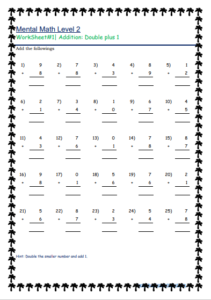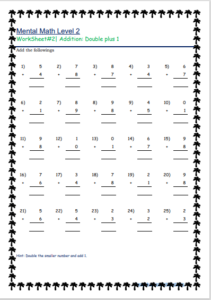Mental math double plus 1 strategy

What Are Mental math double plus 1 strategy ?
Using a Mental math double plus 1 strategy-based approach to adding and subtracting helps to master addition and subtraction facts. One such strategy we use to understand addition or subtraction facts is the doubles strategy or fact.
4 + 4 = 8 is a doubles fact. Doubles fact can help us know other additional strategies like doubles plus one. This strategy is used in the addition of two consecutive numbers, like 2 + 3. Here, we break one of the addends to make a double with the other addend.
When we add two of the same number, we add using the “doubles fact”.
For example, 1 + 1 and 2 + 2 are both doubles facts.

WHAT IS A NEAR Mental math double plus 1 strategy?
A near double is a math fact that is close to a doubles fact. For example, 6+7 is considered a near double because it is close to the doubles fact 6+6.
Near doubles could be doubles plus one facts, doubles plus two facts, or doubles minus one facts.
Let’s take a look at the doubles fact 5+5. 5+6 would be the double plus one (5+5 plus one more). 5+7 would be the double plus two (5+5 plus two more). 5+4 would be the double minus one (5+5 subtract one).
- To add two numbers mentally, add the digits separately.
- Add the tens digits and then look at the ones digits to decide what the answer ends in.
- For example in 32 + 29, we add the tens digits first.
- 3 + 2 = 5.
- Adding the ones, 2 + 9 = 11
How to Add Numbers with Mental Math Doubles Plus One Method
Knowing doubles facts lays a foundation for solving doubles plus one addition. Let’s begin by adding two consecutive numbers using this method.
For example, consecutive numbers 8 and 9 have been added using the strategy.
We know that 8 + 8 is 16, so 8 + 9 = 17
Let’s look at another example of this strategy. Use the image to solve 4 + 5.
We know that 4 + 4 = 8, so 4 + 5 = 4 + 4 + 1 = 8 + 1 = 9
What Is the Difference between “Doubles Plus One” and “Doubles Addition”?
Fun Fact!
Doubles plus 1 and doubles minus one are called “near doubles strategies”.
Solved Examples
Solution: Using the doubles plus 1 method:
4 + 3 = 3 + 1+ 3
6 + 7 = 6 + 6 + 1
Example 2: Add using the near doubles fact.
Solution: Since 5 + 5 = 10 , 5 + 6 is one more than 5 + 5.
So, 5 + 6 = 5 + 5 + 1 = 11
Example 3: Solve the following equations using doubles plus 1:
- 101 + 100 = ?
- 40 + 41 = ?
Solution:
- Since we know 100 + 100 = 200,
101 + 100 = 100 + 1 + 100 = 201
- Since we know 40 + 40 = 80,
40 + 41 = 40 + 40 + 1 = 81

